|
|
|
Sort Order |
|
|
|
Items / Page
|
|
|
|
|
|
|
| Srl | Item |
| 1 |
ID:
172178
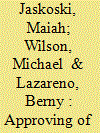

|
|
|
|
|
| Summary/Abstract |
Why do some political radicals—people who believe in using violence for political ends and who may sympathize with local violent groups—not themselves perform violent acts or join violent organizations? This article finds that prior research on terrorism, insurgency, civil war, and ethnic conflict seems to do a poor job of predicting who upon adopting radical political views will actually engage in violence. In fact, there is a great deal of contingency involved in the choice of whether or not to become violent. Employing path dependence, the article treats the radicalizing moment as a “critical juncture,” filled with contingency, but after which actions become more predictable: during this small window of time, radicalized individuals might happen to choose a profession and/or join an organization that is nonviolent, but subsequently become institutionalized as nonviolent actors. The article therefore offers an explanation for how individuals with radical beliefs can be institutionalized as either violent or nonviolent. The study’s findings are based on a content analysis of interviews with 129 nonviolent activists, most of whom exhibited radical beliefs at the time of the interview, and former violent actors, in 12 countries experiencing violent internal conflict.
|
|
|
|
|
|
|
|
|
|
|
|
|
|
|
|
| 2 |
ID:
105085
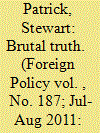

|
|
|
|
|
| Publication |
2011.
|
| Summary/Abstract |
The last 20 years -- so blandly labeled the "post-Cold War era" -- might as well be known as the "Age of Failed States." After decades of confronting Soviet power, successive U.S. administrations suddenly became embroiled in and bedeviled by the world's most dysfunctional countries. Although great-power competition persists, it is often the world's basket cases -- from Somalia to Afghanistan, Haiti to Liberia, and Pakistan to Yemen -- that dominate the U.S. foreign-policy agenda. This trend began in the early 1990s, when a shocking outbreak of state collapse and internal violence, including but by no means limited to episodes of genocide in the former Yugoslavia and Rwanda, seemed to herald a "new world disorder," in the words of British diplomat David Hannay.
|
|
|
|
|
|
|
|
|
|
|
|
|
|
|
|
| 3 |
ID:
130855
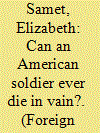

|
|
|
| 4 |
ID:
129883
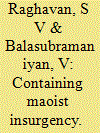

|
|
|
| 5 |
ID:
079107
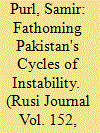

|
|
|
| 6 |
ID:
120879
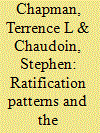

|
|
|
|
|
| Publication |
2013.
|
| Summary/Abstract |
What types of countries have ratified the Rome Statute establishing the International Criminal Court? Because the court relies on state cooperation, it is a good example of a regime facing a "participation problem." In order to be effective, the regime requires active members, but states that fear regime effectiveness will therefore find it potentially costly to join. We analyze the extent to which this problem plagues the ICC. We find that countries for whom compliance is likely to be easiest-democracies with little internal violence-are the most likely countries to join the ICC. On the other hand, countries with the most to fear from ICC prosecution, nondemocracies with weak legal systems and a history of domestic political violence, tend to avoid ratification. We contrast our findings with those of a recent article by Simmons and Danner (2010), arguing that ratification patterns show evidence of credible commitments. Our analysis across a breadth of evidence, both descriptive and multivariate, suggests caution toward arguments about the impact of the ICC on global practices and provides support for the notion that states strategically select themselves into supranational judicial agreements.
|
|
|
|
|
|
|
|
|
|
|
|
|
|
|
|
| 7 |
ID:
129067
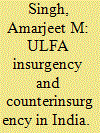

|
|
|
|
|
| Publication |
2014.
|
| Summary/Abstract |
Assam is a land of different cultural groups. Prior to the advent of the Ahoms, the Mongolian people from Thailand, in the 13th century, different regions of Assam were ruled by different dynasties such as Plas, Koches, Kacharis and Chutiyas. The Ahoms invaded Assam in 1236. The land was named "Asom" by the Ahoms (Assam is its an glicised form). Down the line, they have assimilated into the culture of this land.' The Burmese invaded Assam in 1818 and the Ahorns rulers could not stop them. Thus, the British started interfering in the politics of Assam. Assam came under British rule after the Treaty of Yandabo signed between the Burmese and the British in 1826. In 1838, Assam was amalgamated with Bengal. Assam became a province in 1874. In 1905, Bengal was partitioned; Assam was also amalgamated with eastern part of Bengal. In 1912, Bengal was reunited; again, Assam became a province. After the partition of India
and Pakistan in 1947, Sylhet district of Assam (leaving Karimganj to India) was transferred to Pakistan. Finally, Assam became a state of India in 1950. Down the line, the states of Nagaland, Meghalaya, Mizoram and Arunachal Pradesh were created out of Assam. With a population of about 31 million (Indian Census 2011), Assam is one of the most ethnically and linguistically diverse states of India. Assam has been witnessing different kinds of political movements of varying scale ranging from the movement which sought to establish an independent state of Assam to the formation of new states (provinces) within India? Thus Assam has been the victim of violence unleashed by different insurgent groups in which two of them have been banned by the government for seeking
|
|
|
|
|
|
|
|
|
|
|
|
|
|
|
|
|
|
|
|
|